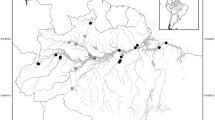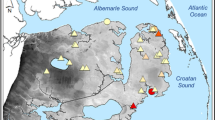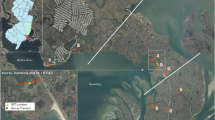Abstract
Salt marsh vegetation often occurs in zones along an elevational gradient. We present a detailed analysis of the distribution of species in a data set of 2,691 plots from salt marshes along the German North Sea coast. For each 1 m2 plot, we estimated species’ percent cover and calculated elevation in relation to mean high tide. For the 19 most frequent species, distribution and dominance pattern along the elevational gradient (correlated with moisture and salinity) were quantified and species’ responses to this gradient analyzed by Huisman-Olff-Fresco (HOF) modelling. Elevational ranges, distribution pattern, and response curves varied widely among the species, with most species’ niches positioned in the middle part of the gradient. Non-parametric multiple comparisons (in total 171) did not reveal significant differences in species’ ranges for 40 species pairings. Most HOF models resulted in unimodal skewed response curves, with the probability of occurrence decreasing towards the lower and more extreme end of the gradient. We conclude that elevation largely explains species distribution within the studied salt marshes and that species ranges follow a continuum along the gradient. Our data provide a baseline for future studies of possible changes in distribution pattern caused by conservation management or sea level rise.






Similar content being viewed by others
References
Adam P (1993) Saltmarsh ecology, 1st paperback edn. Cambridge studies in ecology. University Press, Cambridge
Austin MP (1990) Community theory and competition in vegetation. In: Grace JB, Tilman D (eds) Perspectives on plant competition. Academic, San Diego, pp 215–238
Austin M (2007) Species distribution models and ecological theory: a critical assessment and some possible new approaches. Ecological Modelling 200:1–19
Beeftink WG (1966) Vegetation and habitat of the salt marshes and beach plains in the South-Western part of the Netherlands. Wentia 15:83–108
Beeftink WG (1977a) The coastal salt marshes of Western and Northern Europe: an ecological and phytosociological approach. In: Chapman VJ (ed) Ecosystems of the World I, wet coastal ecosystems. Elsevier, Amsterdam, pp 109–155
Beeftink WG (1977b) Salt-marshes. In: Barnes RSK (ed) The coastline. Wiley, London, pp 93–121
Beeftink WG (1987) Vegetation responses to changes in tidal inundations of salt marshes. In: van Andel J, Bakker JP, Snaydon RW (eds) Disturbance in grasslands. Junk, Dordrecht, pp 97–117
Behre K-E (2005) Meeresspiegelanstieg—Marschentwicklung—Küstenlinien. Die letzten 10000 Jahre an der deutschen Nordseeküste im Zeitraffer. In: Fansa M (ed) Kulturlandschaft Marsch. Natur, Geschichte, Gegenwart. Vorträge anlässlich des Symposiums in Oldenburg vom 3. bis 5. Juni 2004. Schriftenreihe des Lan - desmuseum für Natur und Mensch 33. Isensee, Oldenburg, pp 25–36
Bertness MD, Ellison AM (1987) Determinants of pattern in a New England salt marsh plant community. Ecological Monographs 57:129–147
Bertness MD, Pennings SC (2000) Spatial variation in process and pattern in salt marsh plant communities in Eastern North America. In: Weinstein MP, Kreeger DA (eds) Concepts and controversies in tidal marsh ecology. Kluwer, Dordrecht, pp 39–57
Bio AMF, Alkemade R, Barendregt A (1998) Determining alternative models for vegetation response analysis: a non-parametric approach. Journal of Vegetation Science 9:5–16
Bleakney JS (1972) Ecological implications of annual variation in tidal extremes. Ecology 53:933–938
Bockelmann A-C, Neuhaus R (1999) Competitive exclusion of Elymus athericus from a high-stress habitat in a European salt marsh. Journal of Ecology 87:503–513
Bockelmann A-C, Bakker JP, Neuhaus R, Lage J (2002) The relation between vegetation zonation, elevation and inundation frequency in a Wadden Sea salt marsh. Aquatic Botany 73:211–221
Chapman VJ (1960) Salt marshes and salt deserts of the world. Leonhard Hill, London; Interscience Publishers, New York
Clarke LD, Hannon NJ (1967) The mangrove swamp and saltmarsh communities of the Sydney district. I. Vegetation, soils and climate. Journal of Ecology 55:753–771
Clarke LD, Hannon NJ (1969) The mangrove swamp and saltmarsh communities of the Sydney district. II. The holocoenotic complex with particular reference to physiography. Journal of Ecology 57:213–234
Coudun C, Gégout J-C (2005) Ecological behaviour of herbaceous forest species along the pH gradient: a comparison between oceanic and semi continental regions in northern France. Global Ecology and Biogeography 14:263–270
Coudun C, Gégout J-C (2006) The derivation of species response curves with Gaussian logistic regression is sensitive to sampling intensity and curve characteristics. Ecological modelling 199:164–175
Crain CM, Silliman BR, Bertness SL, Bertness MD (2004) Physical and biotic drivers of plant distribution across estuarine salinity gradients. Ecology 85:2539–2549
Deutsches Hydrographisches Institut Hamburg (1989) Hoch- und Niedrigwasserzeiten für die Deutsche Bucht und deren Flußgebiete 1990. Hamburg
Dierßen K, Eischeid I, Härdtle W, Hagge H, Hamann U, Kiehl K, Körber P, Lütke Twenhöven F, Neuhaus R, Walter J (1991) Geobotanische Untersuchungen an den Küsten Schleswig-Holsteins (Veröffentlichung Nr. 5 des Projektes Ökosystemforschung Wattenmeer). Berichte der Reinhold-Tüxen-Gesellschaft 3 (Rintelner Symposium II):129–155. Hannover
Dijkema KS (1983) The salt-marsh vegetation of the mainland coast, estuaries and halligen. In: Dijkema KS, Wolff WJ (eds) Flora and vegetation of the Wadden Sea Islands and coastal areas. Report 9: final report of the section ‘flora and vegetation of the islands’ of the Wadden Sea working group. Balkema, Rotterdam, pp 185–220
Dijkema KS (1984) General Introduction to the salt marsh ecosystems in Europe. Development and classification of main salt marsh biotopes in Europe. In: Dijkema KS (ed) Salt marshes in Europe. Council of Europe. European Committee for the Conservation of Nature and natural Resources, Straßbourg, pp 8–15
Dijkema KS, Heydemann B (1984) Description of salt marsh ecosystems in Europe. Western-European salt marshes: Wadden Sea and southwest Netherlands. In: Dijkema KS (ed) Salt marshes in Europe. Council of Europe. European Committee for the Conservation of Nature and natural Resources, Straßbourg, pp 82–103
Ellenberg H, Weber HE, Düll R, Wirth V, Werner W, Paulissen D (1992) Zeigerwerte von Pflanzen in Mitteleuropa, 2nd edn. Scripta Geobotanica 18:1–258. Verlag Erich Goltze, Göttingen
Engels JG, Jensen K (2009) Patterns of wetland plant diversity along estuarine stress gradients of the Elbe (Germany) and Connecticut (USA) Rivers. Plant Ecology & Diversity 2:301–311. doi:10.1080/17550870903508947
Esselink P, Zijlstra W, Dijkema KS, van Diggelen R (2000) The effects of decreased management on plant species distribution patterns in a salt marsh nature reserve in the Wadden Sea. Biological Conservation 93:61–76
Garve E (1982) Die Atriplex-Arten (Chenopodiaceae) der deutschen Nordseeküste. Tuexenia 2:287–333
Gauch HG Jr, Whittaker RH (1972) Coenocline simulation. Ecology 53:446–451
Gégout J-C, Pierrat J-C (1998) L’autécologie des espèces végétales: une approche par régression non paramétrique. Écologie 29:473–482
Gillner V (1965) Salt marsh vegetation in Southern Sweden. Acta Phytogeographica Suecica 50:97–104
Gotelli NJ, Ellison AM (2004) A primer of ecological Statistics. Sinauer, Sunderland
Grandt E (2007) vEGplan, Version 1.9c, Hamburg/Germany
Gray AJ, Mogg RJ (2001) Climate impacts on pioneer saltmarsh plants. Climate Research 18:105–112
Gray AJ, Marshall DF, Raybould AJ (1991) A century of evolution in Spartina anglica. Advances in Ecological Research 21:1–62
Haacks M (2003) Die Küstenvegetation von Neuseeland. Mitteilungen der Geographischen Gesellschaft in Hamburg 95:1–269
Heydemann B, Müller-Karch J (1980) Biologischer Atlas Schleswig-Holstein—Lebensgemeinschaften des Landes. Wachholtz, Neumünster
Heykena A (1970) Die Vegetation des Vorlandes bei Hilgenriedersiel. Forschungsstelle Norderney—Jahresbericht 20/1968:87–104
Hill MO, Gauch HG Jr (1980) Detrended correspondence analysis: an improved ordination technique. Vegetatio 42:47–58
Huisman J, Olff H, Fresco LFM (1993) A hierarchical set of models for species response analysis. Journal of Vegetation Science 4:37–46
Hutchinson GE (1957) Concluding remarks. Cold Spring Harbor Symposium. Quantitative Biology 22:415–427
Käfer J, Witte JP (2004) Cover-weighted averaging of indicator values in vegetation analyses. Journal of Vegetation Science 15:647–652
Kötter F (1961) Die Pflanzengesellschaften im Tidegebiet der Unterelbe. Archiv Hydrobiologie, Supplement-Band XXVI “Untersuchungen des Elbe-Aestuars” 1/2:106–184. Schweizerbart’sche Verlagsbuchhandlung, Stuttgart
Kovach Computing Services (2004) MVSP—Multiple Variate Statistical Package, Version 3.13 m. http://www.kovcomp.com
Landesamt für den Nationalpark Schleswig-Holsteinisches Wattenmeer und Umweltbundesamt (1998) Umweltatlas Wattenmeer. Band I: Nordfriesisches und Dithmarscher Wattenmeer. Ulmer, Stuttgart
Mendelssohn IA, Morris JT (2000) Eco-physiological controls on the productivity of Spartina alterniflora Loisel. In: Weinstein MP, Kreeger DA (eds) Concepts and controversies in tidal marsh ecology. Kluwer Academic Publishers, New York, pp 59–80
Nagelkerke NJD (1991) A note on general definition of the coefficient of determination. Biometrika 78:691–692
Oksanen J, Minchin PR (2002a) Continuum theory revisited: what shape are species responses along ecological gradients? Ecological Modelling 157:119–129
Oksanen J, Minchin PR (2002b) Non-linear maximum likelihood estimation of Beta and HOF response models. http://cc.oulu.fi/∼jarioksa/softhelp/hof3.pdf
Olff H, de Leeuw J, Bakker JP, Platerink RJ, van Wijnen HJ, de Munck W (1997) Vegetation succession and herbivory in a salt marsh: changes induced by sea level rise and silt deposition along an elevational gradient. Journal of Ecology 85:799–814
Pakeman RJ, Reid CL, Lennon JJ, Kent M (2008) Possible interactions between environmental factors in determining species optima. Journal of Vegetation Science 19:201–208
Pennings SC, Richards CL (1998) Effects of wrack burial in salt-stressed habitats: Batis maritima in a southwest Atlantic salt marsh. Ecography 21:630–638
Peppler-Lisbach C (2008) Using species environmental amplitudes to predict pH values from vegetation. Journal of Vegetation Science 19:437–444
Prokosch P, Kempf N (1988) Die Nutzung der Salzwiesen im schleswig-holsteinischen Wattenmeer. In: Kempf N, Lamp J, Prokosch P (eds) Salzwiesen: Geformt von Küstenschutz, Landwirtschaft oder Natur? Tagungsbericht 1 der Umweltstiftung WWF Deutschland, 2nd edn. Husum Druck- und Verlagsgesellschaft, Husum, pp 101–112 and pp 140–147
R Development Core Team (2008) R: A language and environment for statistical computing, reference index version 2.2.1. R Foundation for Statistical Computing, Vienna, http://www.R-project.org
Ranwell DS (1972) Ecology of salt marshes and sand dunes. Chapman & Hall, London, reprint 1975
Russell PJ, Flowers TJ, Hutchings MJ (1985) Comparison of niche breadths and overlaps of halophytes on salt marshes of differing diversity. In: Beeftink WG, Rozema J, Huiskes AHL (eds) Ecology of Coastal Vegetation. Vegetatio 61/62:171–178
Rydgren K, Økland RH, Økland T (2003) Species response curves along environmental gradients. A case study from SE Norwegian swamp forests. Journal of Vegetation Science 14:869–880
Sánchez JM, Izco J, Medrano M (1996) Relationships between vegetation zonation and altitude in a salt-marsh system in northwest Spain. Journal of Vegetation Science 7:695–702
Schröder HK, Kiehl K, Stock M (2002) Directional and non-directional vegetation changes in a temperate salt marsh in relation to biotic and abiotic factors. Journal of Vegetation Science 5:33–44
Schröder HK, Andersen HE, Kiehl K (2005) Rejecting the mean: estimating the response of fen plant species to environmental factors by non linear quantile regression. Journal of Vegetation Science 16:373–382
Siegel S, Castellan NJ Jr (1988) Nonparametric statistics for the behavioral sciences, 2nd edn. McGraw-Hill, New York
Silvestri S, Defina A, Marani M (2005) Tidal regime, salinity and salt marsh plant zonation. Estuarine, Coastal and Shelf Science 62:119–130
Snow AA, Vince SW (1984) Plant zonation in an Alaskan salt marsh. II An experimental study of the role of edaphic conditions. Journal of Ecology 72:669–684
StatSoft, Inc. (2007) STATISTICA für Windows (Software-System für Datenanalyse), Version 8.0. www.statsoft.com
Stock M (1993) Salt marshes in Schleswig-Holstein: from a green towards a natural succession. Wadden Sea Newsletter 1:11–14
Stock M, Kiehl K, Reinke HD (1997) Salzwiesenschutz im schleswig-holsteinischen Wattenmeer. Schriftenreihe Nationalpark Schleswig-Holsteinisches Wattenmeer 7:1–47
Stock M, Gettner S, Hagge H, Heinzel K, Kohlus J, Stumpe H (2005) Salzwiesen an der Westküste von Schleswig-Holstein 1988–2001. Schriftenreihe Nationalpark Schleswig-Holsteinisches Wattenmeer 15:1–239
ter Braak CJF (1986) Canonical correspondence analysis: a new eigenvector technique for multivariate direct gradient analysis. Ecology 67:1167–1179
ter Braak CJF, Looman CWM (1986) Weighted averaging, logistic regression and the Gaussian response model. Vegetatio 65:3–11
Tichý L (2002) JUICE, software for vegetation classification. Journal of Vegetation Science 13:451–453
van Bernem KH, Grotjahn M, Knüpling J, Müller A, Neugebohrn L, Ramm G, Sach G, Suchrow S (1992) Thematic mapping and sensitivity study of mudflat areas in the German Wadden sea. In: Dankers M, Smit CJ, Scholl M (eds) Proceedings of the 7th International Wadden Sea Symposium. Ameland, the Netherlands, 22–26 October 1990. Publication Series Netherlands Institute for Sea Research No. 20, the Netherlands, pp 237–238
Vinther N, Christiansen C, Bartholdy J (2001) Colonisation of Spartina on a tidal water divide, Danish Wadden Sea. Danish Journal of Geography 101:11–20
Wierda A, Fresco LFM, Grootjans AP, van Diggelen R (1997) Numerical assessment of plant species as indicators of the groundwater regime. Journal of Vegetation Science 8:707–716
Wisskirchen R, Haeupler H (1998) Standardliste der Farn- und Blütenpflanzen Deutschlands. Ulmer, Stuttgart
Acknowledgments
We thank all management and contracting authorities for supporting this project, especially the Schleswig-Holstein Agency for Coastal Defence, National Park and Marine Conservation National Park Authority for providing data from tide gauges along the North Sea coast and Dr. Martin Stock for constructive cooperation. We also thank Rüdiger Prieß for field assistance, Jens Oldeland and Dr. Cord Peppler-Lisbach for helpful advice on using R software, and anonymous reviewers and Editors for comments that improved the manuscript. Tom Maxfield reviewed the English in the paper.
Author information
Authors and Affiliations
Corresponding author
Electronic Supplementary Material
Below is the link to the electronic supplementary material.
ESM 1
(DOC 134 kb)
Rights and permissions
About this article
Cite this article
Suchrow, S., Jensen, K. Plant Species Responses to an Elevational Gradient in German North Sea Salt Marshes. Wetlands 30, 735–746 (2010). https://doi.org/10.1007/s13157-010-0073-3
Received:
Accepted:
Published:
Issue Date:
DOI: https://doi.org/10.1007/s13157-010-0073-3




